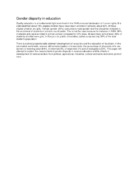| dc.description.abstract | Quality education is a fundamental right enshrined in the 1948 universal declaration of human rights. It is estimated that about 18% eligible children have never been enrolled in schools; about 62% of these eligible children are girls. Female gender (53%) outnumbers male gender and this should be reflected in the enrolment of students in schools countrywide. This is not the case because for instance in 1999, 48% of eligible girls were enrolled in primary school compared to 52% boys. At secondary school level, 46% of students enrolled were girls. In Kenya s six public universities, ladies comprise only 30% of the total student's population.
There is a direct proportionality between development of a country and the education of its citizen. In the job market world wide, science still remains bastion of masculinity, the percentage of physicists who are women is hovering around 4%, ofchemists 8%, of engineers 2% and of biologists is 20%. This paper will attempt to explain the reasons behind gender disparity in science education and its effects in development of various sectors from political, agricultural, industrial, cultural and socio-economic point of view. | en_US |

